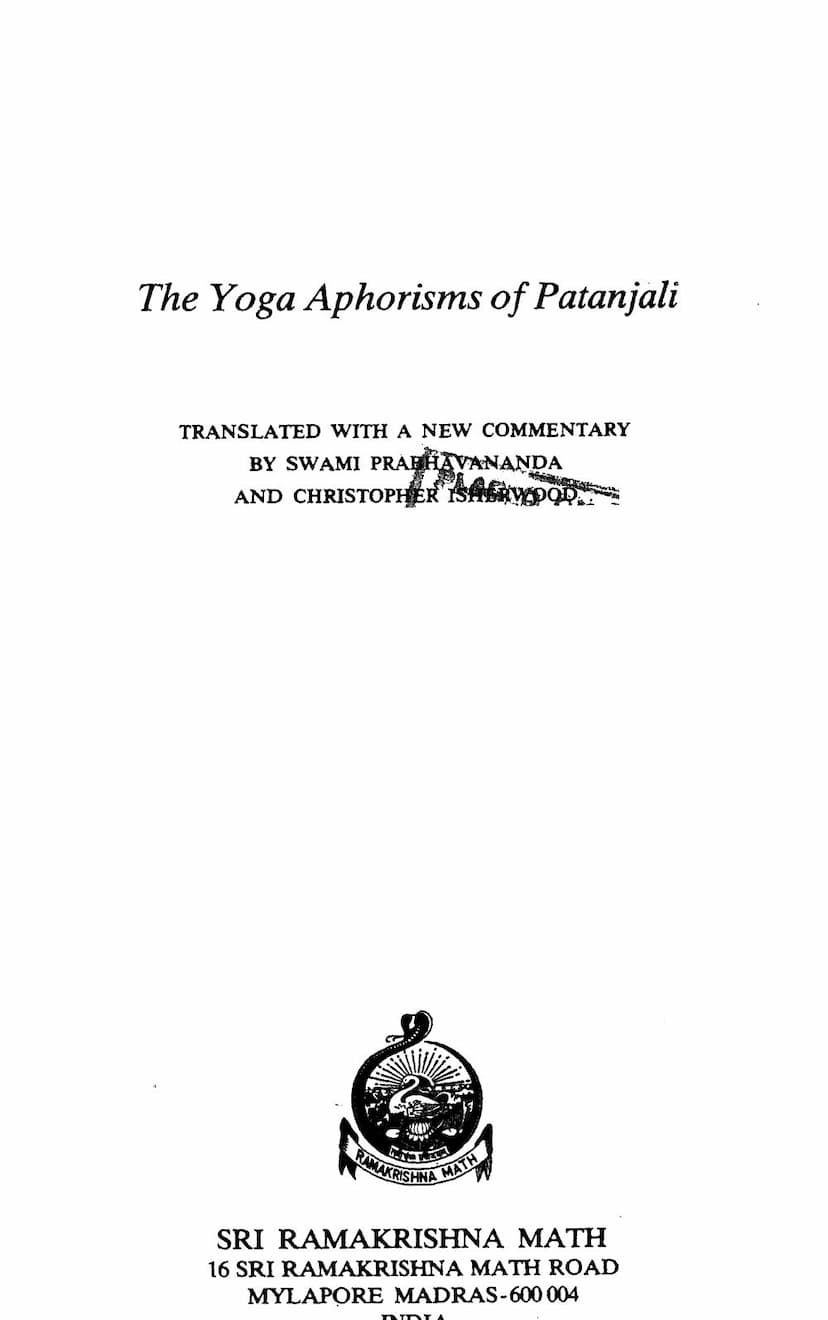Yoga Aphorisms Of Patanjali
Added to library: September 2, 2025

Summary
This document is an Indian edition of "How to Know God" by Swami Prabhavananda, which is an English translation of Patanjali's Yoga Sutras with a new commentary by Swami Prabhavananda and Christopher Isherwood. The book aims to present the philosophy and practice of Yoga in an accessible way, even for those unfamiliar with Sanskrit.
The core of Patanjali's Yoga, as presented here, is to achieve "union" (yoga) with the Godhead or the underlying Reality (Atman). This is accomplished through the control of thought-waves in the mind.
Here's a breakdown of the key concepts covered in the provided text:
I. Yoga and Its Aims:
- Definition of Yoga: Union with the Godhead, separating the Atman (the Reality) from the non-Atman (the apparent).
- The Mind: Composed of manas (recording faculty), buddhi (discriminative faculty), and ahamkara (ego-sense). Yoga aims to control the thought-waves (vrittis) generated by these components.
- The Atman (Purusha): The true Self, pure consciousness, and the underlying Reality. It is often referred to as the "God-within-the-creature."
- Thought-Waves: All perceptions, knowledge, and even self-knowledge are considered thought-waves. These waves, when identified with the ego-sense, cause misery.
- Samskaras: Latent tendencies or imprints in the subconscious mind, formed by repeated thoughts and actions. These form one's character and influence future experiences and rebirths.
- The Goal: To still these thought-waves and the ego-sense, allowing the individual to abide in their real nature (the Atman).
- Types of Thought-Waves: Patanjali identifies five types: right knowledge (perception, inference, scriptural testimony), wrong knowledge, verbal delusion, sleep, and memory.
- Control: Thought-waves are controlled by practice (abhyasa) and non-attachment (vairagya).
- Practice: Repeated effort to control thought-waves.
- Non-attachment: Self-mastery and freedom from desire for what is seen or heard.
- The Gunas: Prakriti (the elemental stuff of mind and matter) is composed of three forces: Sattwa (purity, tranquility), Rajas (action, motion), and Tamas (inertia, darkness). The interaction of these gunas creates the universe. Yoga aims to transcend them.
- Stages of Concentration: The text describes four stages of concentration on a single object, progressing from gross elements to subtle essences, then to inner powers and finally to the ego-sense.
- Higher Concentration (Seedless Samadhi): This occurs when the mind moves beyond all objects and unites with pure, undifferentiated consciousness. It is attained when thought-waves and samskaras are stilled.
- Ishwara: God as He appears within Prakriti. Devotion to Ishwara is a path to concentration, offering humility and service.
- The Word OM: The sacred sound representing the ultimate Reality, to be repeated with meditation on its meaning.
- Obstacles to Yoga: Sickness, mental laziness, doubt, lack of enthusiasm, sloth, craving for sense-pleasure, false perception, despair, and unsteadiness. These are accompanied by grief, despondency, trembling, and irregular breathing.
- Cultivating Calmness: Achieved through friendliness towards the happy, compassion for the unhappy, delight in the virtuous, and indifference towards the wicked. Also through breath control (pranayama) and concentration on specific objects or inner light.
- Samadhi: The state of absorption or union with the Atman. Different types are described, including savitarka, nirvitarka, savichara, and nirvichara samadhi, leading eventually to the "seedless" samadhi (nirvikalpa).
- Knowledge through Samadhi: This is a direct, supersensory knowledge that goes beyond inference and scriptures, confirming spiritual truths.
II. Yoga and Its Practice:
- Kriya Yoga (Preliminary Steps): Austerity (tapas - conserving and directing energy), study (scriptures, japam), and dedication of the fruits of one's work to God (karma yoga).
- Obstacles (Kleshas): Ignorance (avidya), egoism (asmita), attachment (raga), aversion (dvesha), and the desire to cling to life (abhinivesha). Ignorance is the root of the others.
- Avidya: Regarding the non-eternal as eternal, the impure as pure, the painful as pleasant, and the non-Atman as the Atman.
- Asmita: Identifying consciousness with that which merely reflects consciousness (the mind).
- Raga & Dvesha: Attachment to pleasure and aversion to pain.
- Abhinivesha: The inherent desire to cling to life, even in the learned, due to subconscious memories of death.
- Reincarnation: The doctrine of rebirth, where one's current state is conditioned by past actions (karma) and influences future lives. It emphasizes personal responsibility.
- The Eight Limbs of Yoga (Ashtanga Yoga):
- Yama: Abstention from harming, falsehood, theft, incontinence, and greed.
- Niyama: Observances like purity (physical and mental), contentment, austerity, study, and devotion to God.
- Asana: A steady, relaxed posture.
- Pranayama: Control of prana (vital energy), primarily through breath control.
- Pratyahara: Withdrawal of the mind from sense-objects.
- Dharana: Concentration.
- Dhyana: Meditation (uninterrupted flow of thought).
- Samadhi: Absorption or union.
- Yogas (Paths to Union): Bhakti yoga (devotion), Karma yoga (selfless action), Jnana yoga (discrimination), and Raja yoga (meditation).
III. Powers:
- Samyama: The combined practice of dharana, dhyana, and samadhi on a single object.
- Psychic Powers: Patanjali describes various powers gained through samyama, such as knowledge of past lives, telepathy, invisibility, mastery over elements, and knowledge of the cosmos.
- Caution: These powers are considered worldly accomplishments and obstacles to the ultimate goal of samadhi (liberation). True spiritual progress lies in transcending them.
IV. Liberation:
- Kaivalya: Liberation, the ultimate goal, achieved when the Atman realizes its true nature, independent of Prakriti and the gunas.
- The Role of Karma: Karma creates tendencies that bind one to the cycle of birth and death. Liberation involves transcending karma by removing ignorance.
- The Ultimate Stage: The mind becomes pure and indistinguishable from the Atman, leading to "seedless" samadhi (nirvikalpa samadhi).
- The Gunas: Their purpose is fulfilled when liberation is attained, and they resolve back into Prakriti.
In essence, the book provides a comprehensive guide to Patanjali's Yoga Sutras, explaining its philosophical underpinnings, practical techniques, and the ultimate aim of spiritual liberation through union with the Atman. It emphasizes the importance of discipline, non-attachment, and consistent practice in overcoming the obstacles of the mind and achieving self-realization.